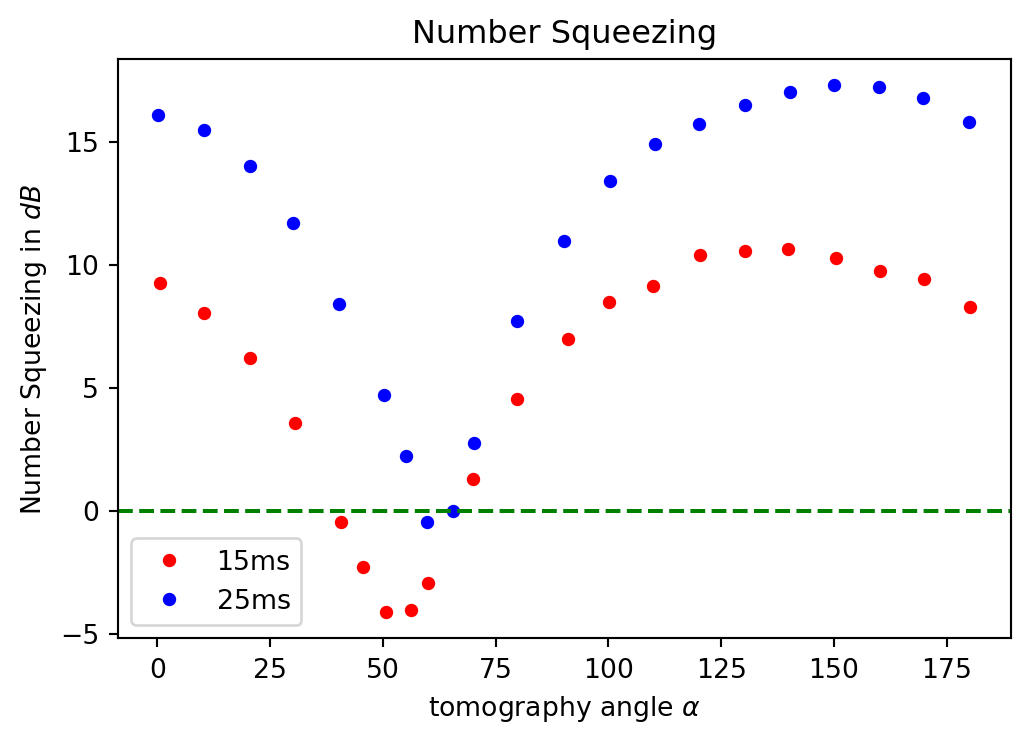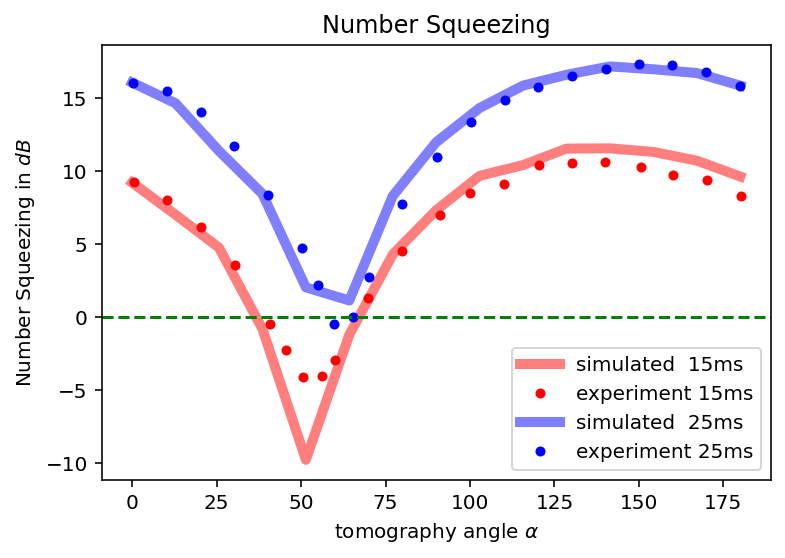Squeezing in atomic qudits¶
In this notebook we will look into experiments with atomic qudits and reproduce them with pennylane. We first want to look at what we are trying to reproduce with pennylane. The graph below is from a paper by Helmut Strobel. In this paper the collective spin of a Bose-Einstein-Condensate is used to observe nonlinearity in spin squeezing.
import pennylane as qml
import numpy as np
import matplotlib.pyplot as plt
import pandas as pd
%config InlineBackend.figure_format='retina'
data_strobel_15 = pd.read_csv("Data/Strobel_Data_15ms.csv", names=["dB", "alpha"])
data_strobel_25 = pd.read_csv("Data/Strobel_Data_25ms.csv", names=["dB", "alpha"])
plt.figure(dpi=96)
plt.title("Number Squeezing")
plt.plot(data_strobel_15.dB, data_strobel_15.alpha, "ro", label="15ms", markersize=4)
plt.plot(data_strobel_25.dB, data_strobel_25.alpha, "bo", label="25ms", markersize=4)
plt.axhline(y=0, color="g", linestyle="--")
plt.ylabel(r"Number Squeezing in $dB$")
plt.xlabel(r"tomography angle $\alpha$")
_ = plt.legend()

This number squeezing is achieved by performing the following Bloch-sphere rotations.
We prepare the collective spin such that the Bloch-sphere-vector points to one of the poles.
First step. As a first step the vector is rotated onto the equator.

Second step . Then the state is being squeezed, such that it starts to wrap around the Bloch-sphere.

Third step . In the last step we rotate the state around the \(X\)-axis. This rotation corresponds to the angle \(\alpha\) in this notebook.

We will now simulate the sequence in pennylane.
import pennylane as qml
import numpy as np
from pennylane_ls import *
import the credentials to access the server and import the device. Make sure that you followed the necessary steps for obtaining the credentials as desribed in the introduction.
from heroku_credentials import username, password
nshots = 500
testDevice = qml.device("synqs.sqs", shots=nshots, username=username, password=password)
This created a single qudit device, which has the following operations.
testDevice.operations
{'load', 'rLx', 'rLz', 'rLz2'}
we now define the quantum circuit that implements the experimental sequence
@qml.qnode(testDevice)
def quantum_circuit(Nat=10, theta=0, kappa=0, alpha=0, Ntrott=2):
"""
The circuit that simulates the experiments.
theta ... angle of the Lx term in the Hamiltonian evolution
kappa ... angle of the Lz^2 term in the Hamiltonian evolution
apla ... angle of rotation
"""
# load atoms
SingleQuditOps.load(Nat, wires=0)
# rotate onto x
SingleQuditOps.rLx(np.pi / 2, wires=0)
SingleQuditOps.rLz(np.pi / 2, wires=0)
# evolution under the Hamiltonian
for ii in range(Ntrott):
SingleQuditOps.rLx(theta / Ntrott, wires=0)
SingleQuditOps.rLz2(kappa / Ntrott, wires=0)
# and the final rotation to test the variance
SingleQuditOps.rLx(-alpha, wires=0)
return qml.var(SingleQuditOps.Z(0))
the parameters of the experiment.
Nat = 200
l = Nat / 2 # spin length
omegax = 2 * np.pi * 20
t1 = 15e-3
t2 = 25e-3
Lambda = 1.5
# 1.5
chi = Lambda * abs(omegax) / Nat
Ntrott = 15;
let us visualize it once.
quantum_circuit(Nat, omegax * t1, chi * t1, 0, Ntrott)
tensor(440.701964, requires_grad=True)
print(quantum_circuit.draw())
0: ──load(200)──rLx(1.57)──rLz(1.57)──rLx(0.126)──rLz2(0.000942)──rLx(0.126)──rLz2(0.000942)──rLx(0.126)──rLz2(0.000942)──rLx(0.126)──rLz2(0.000942)──rLx(0.126)──rLz2(0.000942)──rLx(0.126)──rLz2(0.000942)──rLx(0.126)──rLz2(0.000942)──rLx(0.126)──rLz2(0.000942)──rLx(0.126)──rLz2(0.000942)──rLx(0.126)──rLz2(0.000942)──rLx(0.126)──rLz2(0.000942)──rLx(0.126)──rLz2(0.000942)──rLx(0.126)──rLz2(0.000942)──rLx(0.126)──rLz2(0.000942)──rLx(0.126)──rLz2(0.000942)──rLx(0)──┤ Var[Z]
and now calculate the variance as presented above.
alphas = np.linspace(0, np.pi, 15)
variances_1 = np.zeros(len(alphas))
variances_2 = np.zeros(len(alphas))
for i in range(len(alphas)):
if i % 10 == 0:
print("step", i)
# Calculate the resulting states after each rotation
variances_1[i] = quantum_circuit(Nat, omegax * t1, chi * t1, alphas[i], Ntrott)
variances_2[i] = quantum_circuit(Nat, omegax * t2, chi * t2, alphas[i], Ntrott)
step 0
step 10
def number_squeezing_factor_to_db(var_CSS, var):
return 10 * np.log10(var / var_CSS)
f, ax = plt.subplots()
ax.set_title("Number Squeezing")
plt.plot(
np.rad2deg(alphas),
number_squeezing_factor_to_db(l / 2, variances_1),
"r-",
lw=5,
label="simulated 15ms",
alpha=0.5,
)
ax.plot(
data_strobel_15.dB,
data_strobel_15.alpha,
"ro",
label="experiment 15ms",
markersize=4,
)
plt.plot(
np.rad2deg(alphas),
number_squeezing_factor_to_db(l / 2, variances_2),
"b-",
lw=5,
label="simulated 25ms",
alpha=0.5,
)
ax.plot(
data_strobel_25.dB,
data_strobel_25.alpha,
"bo",
label="experiment 25ms",
markersize=4,
)
ax.axhline(y=0, color="g", linestyle="--")
ax.set_ylabel(r"Number Squeezing in $dB$")
ax.set_xlabel(r"tomography angle $\alpha$")
ax.legend()
<matplotlib.legend.Legend at 0x27fe3f4c6a0>

